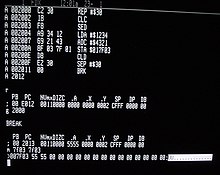
Back لغة الآلة Arabic Maşın kodu Azerbaijani Машынны код Byelorussian Машинен език Bulgarian যান্ত্রিক ভাষা Bengali/Bangla Areg ijinenn Breton Mašinski jezik BS Llenguatge de màquina Catalan کۆدی مەکینە CKB Strojový kód Czech
| Program execution |
|---|
| General concepts |
| Types of code |
| Compilation strategies |
| Notable runtimes |
|
| Notable compilers & toolchains |
|

In computer programming, machine code is computer code consisting of machine language instructions, which are used to control a computer's central processing unit (CPU). For conventional binary computers, machine code is the binary representation of a computer program which is actually read and interpreted by the computer. A program in machine code consists of a sequence of machine instructions (possibly interspersed with data).[1]
Each machine code instruction causes the CPU to perform a specific task. Examples of such tasks include:
- Load a word from memory to a CPU register
- Execute an arithmetic logic unit (ALU) operation on one or more registers or memory locations
- Jump or skip to an instruction that is not the next one
In general, each architecture family (e.g., x86, ARM) has its own instruction set architecture (ISA), and hence its own specific machine code language. There are exceptions, such as the VAX architecture, which includes optional support of the PDP-11 instruction set; the IA-64 architecture, which includes optional support of the IA-32 instruction set; and the PowerPC 615 microprocessor, which can natively process both PowerPC and x86 instruction sets.
Machine code is a strictly numerical language, and it is the lowest-level interface to the CPU intended for a programmer. Assembly language provides a direct map between the numerical machine code and a human-readable mnemonic. In assembly, numerical opcodes and operands are replaced with mnemonics and labels. For example, the x86 architecture has available the 0x90 opcode; it is represented as NOP in the assembly source code. While it is possible to write programs directly in machine code, managing individual bits and calculating numerical addresses is tedious and error-prone. Therefore, programs are rarely written directly in machine code. However, an existing machine code program may be edited if the assembly source code is not available.
The majority of programs today are written in a high-level language. A high-level program may be translated into machine code by a compiler.
- ^ Stallings, William (2015). Computer Organization and Architecture 10th edition. Pearson Prentice Hall. p. 776. ISBN 9789332570405.